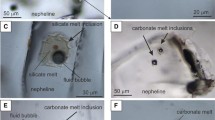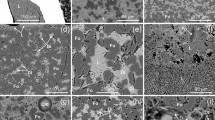Abstract
In order to define the conditions for the formation of immiscible carbonatite magmas in the lithosphere and in the crust, we have conducted phase equilibrium experiments to determine the effect of pressure and temperature on the silicate-carbonate liquid miscibility gap in bulk compositions appropriate for magmas in the upper mantle. A primitive (magnesian) nephelinite (NEPH) was used as a starting material, mixed with carbonates. Experiments were made with mixtures in the joins NEPH-dolomite-Na2CO3 (NEPH-Dol-NC) at 1.0 to 2.5 GPa, and NEPH-calcite (NEPH-CC) at 1.0 GPa. The miscibility gap was intersected by the join NEPH-Dol-NC (liquids with olivine), but not by NEPH-CC. Together with previous results for the Mg-free system (Na2O-CaO-Al2O3-SiO2-CO2), it was established that the size of the miscibility gap for magnesian compositions increases with decreasing pressures from depths of ˜100 km to ˜ 35 km; it increases further as compositions are changed by decreasing Mg/Ca. The maximum CaCO3 in liquids associated with the miscibility gap is 50 wt % for Mg-bearing liquids, and 80 wt % for Mg-free liquids. There is no experimental evidence for nearly pure-CaCO3 immiscible liquids, but abundant evidence for the precipitation of rounded calcite crystals from carbonate-rich liquids. The join NEPH-CC locates a piercing point on the liquidus field boundary for coprecipitation of olivine and calcite at NEPH50CC50 (wt %), part of the silicate-carbonate liquidus field boundary which defines the locus of liquids formed from carbonate-peridotites. The miscibility gap results are compared with magmas formed during partial fusion of CO2-bearing mantle peridotites, and during fractional crystallization of mantle-derived magmas. None of the probable magma paths in mantle processes intersects the miscibility gap. CO2-bearing mantle-derived alkalic magmas such as nephelinites and melilitites may fractionate during uprise through the mantle and crystallization within the crust. The compositions of these evolved nephelinites and phonolites approach the silicate side of the miscibility gap, confirming the probable generation of immiscible, alkalic carbonate-rich liquids at crustal pressures.
Similar content being viewed by others
Author information
Authors and Affiliations
Additional information
Received: 29 January 1996 / Accepted: August 14, 1996
Rights and permissions
About this article
Cite this article
Lee, Wj., Wyllie, P. Liquid immiscibility between nephelinite and carbonatite from 1.0 to 2.5 GPa compared with mantle melt compositions. Contrib Mineral Petrol 127, 1–16 (1997). https://doi.org/10.1007/s004100050261
Issue Date:
DOI: https://doi.org/10.1007/s004100050261




